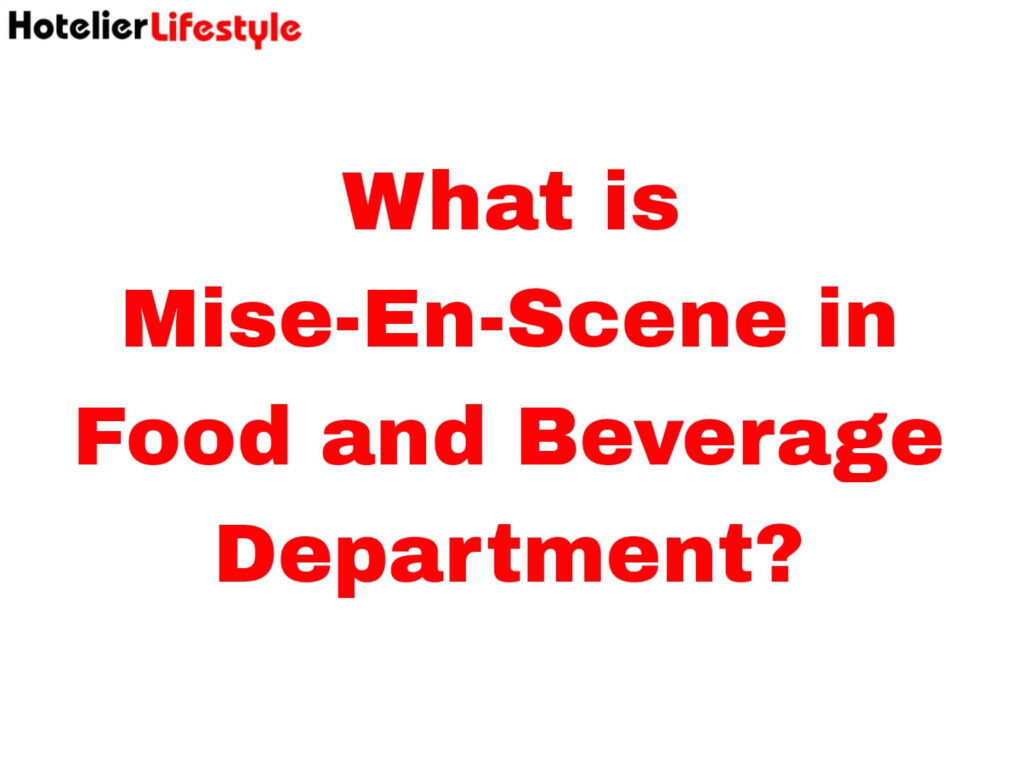In the world of Food and Beverage Department, Mise-En-Scene is the act of arranging and presenting food elements in an interesting way to create a captivating dining experience. It involves planning tables and lighting as well as choosing tableware and embellishments. Every little thing is thoughtfully accounted for in order to achieve a certain mood and bring out the best in each meal. Thus, through strategically placed ingredients, some plating techniques applied attentively and aesthetics considered, Mise-En-Scene transforms a simple meal into a sensory journey where everything contributes to client’s happiness.
Importance of Mise-En-Scene in Food and Beverage Department of a Hotel
What is of utmost importance in the Food and Beverage Department is Mise-En-Scene, because it greatly enhances the overall dining experience. This idea follows a well-done combination of all visual and sensory elements, which play critical role in setting up an inviting atmosphere that could significantly change a guest’s opinion towards their meal. Mise-En-Scene makes sure that each dish is properly presented from the design of the dining area to its decoration in order to integrate every little detail harmoniously with the restaurant’s theme and style.
To begin with, perfectly done mise-en-scène can be a powerful first impression that will set tone for whole dining experience. The moment someone walks into a space that has been beautifully laid out with carefully arranged tables and moderate lighting, it raises their hopes immediately and builds up anticipation. This initial influence can define how one relates well with clients.
First Impression: Mise-En-Scene as an important aspect of food and beverage department to enhance dining experience at large. This is an idea within which proper arrangement of all visuals and sensory elements matter when it comes to creating such welcoming ambiance capable making or breaking guests’ attitude towards their food. From layout of eating section through décor selection down presentation of every plate, Mise-En-Scene guarantees smooth integration of every little thing into restaurants theme as well as style.
For instance, excellent mise-en-scene may make powerful impression serving as a prelude for overall dinner time experience. When entering into aesthetically organized room with carefully placed tables lights dimmed down and low background music on this enhances expectations along with excitement levels. At this stage first impressions are made which determine the level of interaction one has with customers.
Also, Mise-En-Scene is important in distinguishing one restaurant from the others. Mise-en-scene is one of those weird terms that refers to everything involved in the shot, set design and props, costume and makeup, positioning of actors, lighting, camera movement and angles etc. This makes it more appetizing but it also allows customers to capture and share their dining experiences with other people on social media which has become a very big marketing tool today.
Lastly, proper Mise-en-Scène can enhance functional aspects of dining. For instance, client comfort and convenience can be improved through strategic placement of tables and lighting while pleasant auditory ambience can be guaranteed by efficient sound control. The overall design must pay attention to every detail to ensure customer satisfaction thereby increasing repeat business.
To conclude, Mise-En-Scene is a vital aspect of the Food and Beverage Department. It is a part of the whole, making sure that there is a coherent, welcoming and unforgettable eating setting that not only fills but also pleases visitors, thus seeing them off with an indelible positive mark.
Mise-En-Scene in Food and Beverage Department
These are ten examples of Mise-En-Scene in the Food and Beverage Department:
- Table Settings: The careful arrangement of table settings, comprising dishes, glasses, and cutlery to create a perception of an elegant dining experience.
- Ambient Lighting: In this case, a thoughtful selection of lighting fixtures or room ambiance can improve the overall appearance of the restaurant.
- Decor Elements: This could be anything floral arrangements, candles or centerpieces that makes the dining area look different from other places and are used to show what kind of establishment it is or its theme.
- Plate Presentation: An attention to detailed presentation such as garnishing food items with ingredients and arranging them tastefully on plates increases aesthetic value for each dish.
- Uniforms and Attire: Uniforms worn by staff ranging from waiters/waitresses to chefs contribute towards creating a uniformed professional environment in a restaurant setting.
- Menu Design: The arrangement, text laid down and images on the menus can create a sense of aesthetic to the dining experience and affect how diners perceive dishes.
- Open Kitchen Design: Letting customers view kitchens adds transparency and enthusiasm whereby food fans can watch culinary expertise in practice.
- Seasonal Decorations: Freshening up dining areas with changing decorations and seasonal touches like holiday-themed accents or ingredients that are only available for limited periods is what keeps them exciting throughout each year’s 365 days.
Each of these elements when properly selected and combined contributes to Mise-En-Scene of F&B Department making memorable experiences that immerse guests.

